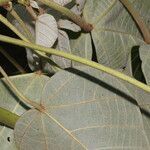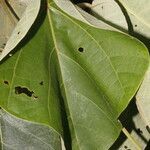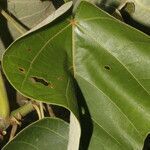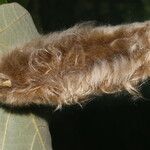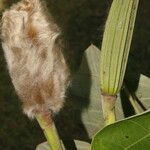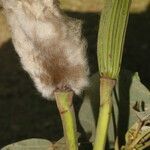Tree 10-30 m. tall, the trunk up to 0.90-1.80 m. in diam., sometimes buttressed, the crown large and spreading, the bark smooth and grayish, the branchlets tufted-puberulous. Leaves with a thick petiole 3-40 cm. long, tomentellous to glabrescent, the stipules ca. 1.5 cm. long and 1 cm. wide; blade broadly ovate, ovate-angulate to ovate and 3-to 5-sublobate, the base generally deeply cordate, sometimes more ro less truncate, the apex or the central lobe obtuse, acute or acuminate, 10-40 cm. long and 11-35 cm. wide, chartaceous, the margins generally undulate, the upper surface tomentellous especially when young to glabrous, the lower surface shortly tomentellous, 7(-9)-palminerved, the nervation prominent beneath. Flowers with a pedicel 4-11 cm. long and ca. 0.6-1 cm. in diam., tomentellous; calyx 8-11.5 cm. long, tomentellous outside, sericeous-villous inside, the lobes 2.5-4 cm. long, 2 lobes triangular and acute, the other 3 flabelliform; petals obovate-spatulate, 11-15 cm. long and ca. 5 cm. wide, whitish, puberulous on the upper part outside, glabrous or nearly so inside; staminal column cylindric, enlarged at the base, 10-12.5 cm. long, glabrous, the antheriferous part ca. 5-5.5 cm. long; ovary conical, 5-angulate, ca. 13 mm. long and 7 mm. in diam. at the base, tomentellous at the apex; style ca. 9-10 cm. long, puberulous near the base; stigma ca. 3.5 cm. long. Capsule oblong-fusiform, 5-angulate, 16-25 cm. long and ca. 2.5 cm. in diam., the valves black and glabrous; seeds ca. 5 mm. long; kapok pale brown.
More
A tree. It grows 25 m high. The bark is smooth and grey. The trunk can have buttresses. The branches are thick. The leaf blades are 30 cm long and broad. They have 3-5 lobes. They are softly hairy and grey-green. The flowers are bell shaped and erect. They are 12 cm long. The fruit is a capsule 25 cm long. It opens with 5 valves. There is silvery-brown fluff with many small seeds. The seeds are 5 mm long.
Moist, lowland, limestone forest. Common along the margins of lakes or in disturbed areas, rare in the older forest where it is a large tree. It is found mainly on fertile, bottom-land soils along the sides of streams.
More
It is a tropical plant. In Costa Rica it grows from sea level to 1,200 m altitude. It grows in open areas.
